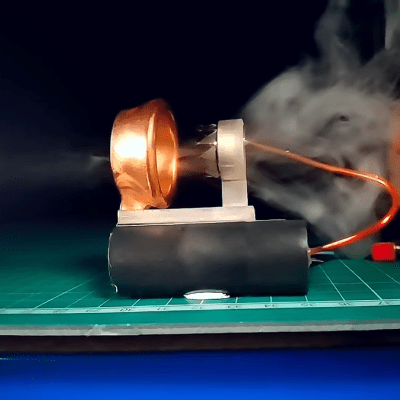Want to generate some thrust by way of an exposed high voltage discharge that looks great when you turn down the lights? [Integza] has a video showing how to do exactly that with some simple components. His little thruster manages to blow out candles at surprising distances before being pressed into service propelling a model boat.
 Here’s how it works: ionic wind is generated when a strong enough electric field causes nearby air to ionize, for example from sharp tips of a conductor carrying a high enough voltage. This discharge creates ionized air molecules with an electrical charge matching the polarity of the nearby conductor. Because matching polarities repel one another, the small cloud of ionized air molecules are repelled from both the nearby conductor, as well as from each other.
Here’s how it works: ionic wind is generated when a strong enough electric field causes nearby air to ionize, for example from sharp tips of a conductor carrying a high enough voltage. This discharge creates ionized air molecules with an electrical charge matching the polarity of the nearby conductor. Because matching polarities repel one another, the small cloud of ionized air molecules are repelled from both the nearby conductor, as well as from each other.
The result is a wind-like force from a device with no moving parts, and if the parts are structured right, it’ll blow out a candle with ease. [Integza] attached a cheap DC high-voltage transformer to a nickel strip cut into sharp points and rolled into a circlet. The other half of the thruster — in contrast to the thin crown of sharp points — is a smooth ring shaped a little like a thruster nozzle. 3D models of the parts are available online should you wish to try it yourself without all the trial and error of trying to optimize.
In an effort to minimize mass, [Integza] electroplates a 3D-printed version of the large ring with great results, spraying it with graphite first to make it conductive. Cheap and safe copper electroplating is entirely within the reach of hobbyists, and the resulting unit does a pretty nice job. You can watch it in action in the video, embedded below.
















If I apply this to make a huge ion table fan, will it be harmful to my health when I use it?
Doesn’t ionizing air create Ozone (O3, which is a pollutant at ground level)?
Generally, these devices don’t create enough ozone to be harmful, but, if you’re wanting it as something large scale and always on, like a fan, it might be a problem.
There was an air purifier a while ago called the ionic breeze or something that was basically this.
No, these ionize argon for thrust. They’re designed for operation in space where there is very little oxygen to ionize. It’s difficult to ionize O2 in air but you can with an old xerox machine.
Argon is used in space but I doubt the ion drive in the video was using argon. After all the creator is also using it to drive a little boat.
And argon wouldn’t be used if someone tried to make a table fan with it.
The thruster in the video is using normal atmosphere. The transformer shown in the video has a typical that ranges between 100kV-1,000kV, plenty to ionize air.
Argon (or other noble gas) Ion/Hall thrusters for spacecraft operate by a fundamentally different mechanism to ‘lifter’ type ion wind generators as in the article.
Ion thrusters work by generating a neutral particle beam purely using on-board propellants. The propellant is ionised, the charged nuclei are accelerated (via different mechanisms depending on thruster type), then ejected from the rear, along with an electron beam to prevent charge building up in the spacecraft (and producing a neutral gas flow).
‘Lifters’ work by entraining neutral particles from the air into a charged wind. The lifter generates two charged particle streams, one blowing forwards (electron stream) and the other backwards (charged molecule stream). Without a surrounding atmosphere, nothing would happen. But because the charged molecules are high in mass, they bounce off of neutral particles in the air and accelerate them, producing a net thrust (the electron stream cannot produce nearly the same induced thrust from neutral particle impacts).
The amount of ozone this could potentially produce might be concerning. I would not point it at my face, and having it on in the same room as you is probably not advisable. Integza is a mad man for running this in his room, I would have relocated outside for testing, or maybe his attic, I’ve seen it in other vids and it seems to be pretty well ventilated.
On a other note, this is the best diy ion thruster I’ve seen on YouTube so far. The plasma guy’s was cool but really inefficient. This runs on a 5v source and has some awesome output for something so small.
I guess it would, but I would be far, far more concerned with the Electrocution / Fire hazard the HV could cause, especially if it has capacitors in it.
This seems to be the transformer used. Can only work for 60s continuously so not great for a fan I guess.
High voltage was used safely in millions of CRTs for decades. It’s something to be cautious of and maybe put a rudimentary lightweight cage around, but it isn’t plutonium.
Yes, but the HV is enclosed in the TV. That’s not the case here.
The highest voltage used in CRTs is about 28.5KV to avoid producing X-rays (according to a TV repair technician I once knew), and it’s well insulated, so probably doesn’t produce much ozone at all. But this is a whole new level in HV though! Ozone will be a thing here.
Couldn’t he have saved a massive amount of weight by running the 3 thrusters in parallel from a single HV coil ? Or am I doing electronics wrong
Snazzy!
Surprised he didn’t use carbon fiber strands instead of metal. Much finer points, which is why it’s used in ozone generators these days. Or did he try that and it didn’t work as well?
As always in his videos they could be faked very easily. For example the candle is only shown closeup, no problem to blow air in from outside the frame.
And besides, NASA only manages to produce 20-92 mN for 2.3kW so he must be a real genius!
There’s no point in faking such a video. Unlike with NASA, this thruster is not in space, but at ground level where it can push regular air just like an airplane propeller, providing a huge multiplying effect.
Maybe there is no reason to fake such a video, he is doing it anyway.
The reason ion thrusters work more effectively in a vacuum is primarily due to the interactions between the ions and the surrounding gas molecules.
In a vacuum, there are very few gas molecules present, which means that there is minimal interaction between the ions expelled by the thruster and any surrounding particles. This lack of interaction allows the ions to maintain their high speed and energy, leading to efficient acceleration and the generation of higher thrust. In contrast, in an atmosphere or any environment with a significant gas density, the ions would collide with gas molecules, leading to a loss of energy and momentum.
See my post upthread: ion drives for spacecraft and ‘lifters’ as in the article are fundamentally different things.
You’ve got it backwards, these kinds of systems can be much more efficient in atmosphere because there’s so more air down here. A lot of slower moving air requires less energy to accelerate than a little bit of fast moving air because the energy required to accelerate it increases quadratically with velocity. Twice the amount of air moving at half the speed has the same momentum and thus thrust but requires half the energy/power. It’s why airplane wings are more efficient than propellor blades, and turbofans than turbojets. When you’re in space and paying for every molecule, you do want every molecule to count, but here on Earth you’re better off letting the air do as much work for you as possible
At what distance from the thruster do the ions stop providing thrust? I may be misunderstanding what you wrote.
There is a huge difference between an atmospheric “wind machine” and an ion engine designed for vacuum use.
And the difference is more than just having to carry the reaction mass with you. They operate completely differently.
Number one, you obviously haven’t watched many of Integza’s videos. Learning from failure is one of his big things, often spectacular failures.
Number two, he has clearly invited you to reproduce, or improve upon his results, with a list of common supplies, and even a free to download 3D model file. Not something Youtube fakers are likely to do.
Number three, you are clearly misinformed on how this mechanism works, and are confusing it with a different type of mechanism, popularly researched as a low thrust, high efficiency space engine.
Integza may be a little weird, but he’s no fake.
Everybody here’s a little funny. Now you funny too.
Now to make a high altitude glider that can keep itself aloft with solar powered “ion jets”. Don’t have the first clue what we’d use it for, but there’s been a lot of solutions that have had to wait years for the appropriate problem to develop.
Before all the pedantic wonder-nerds pile on, I know good and well the power requirements needed for a useable ion based jet engine would far outstrip the output of the most efficient solar panels we have in production. The min-max math on this just isn’t there yet.
That being said, MIT did successfully test a “solid state powered flight” demonstrator 5 years ago. https://news.mit.edu/2018/first-ionic-wind-plane-no-moving-parts-1121
Great hack, especially copper plating.
One wonders why he didn’t use pre formed copper, widely available in rings and tubes.
Obviously as a stepping stone to further research a custom shaped thruster is preferred.